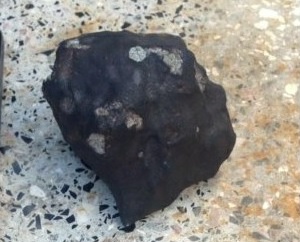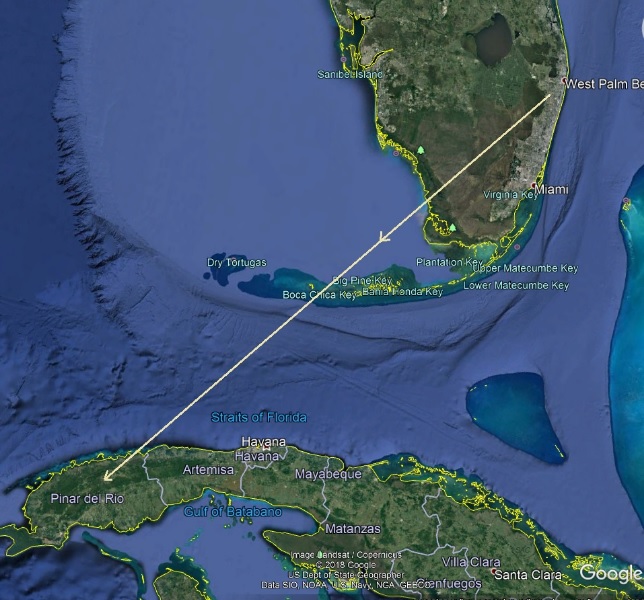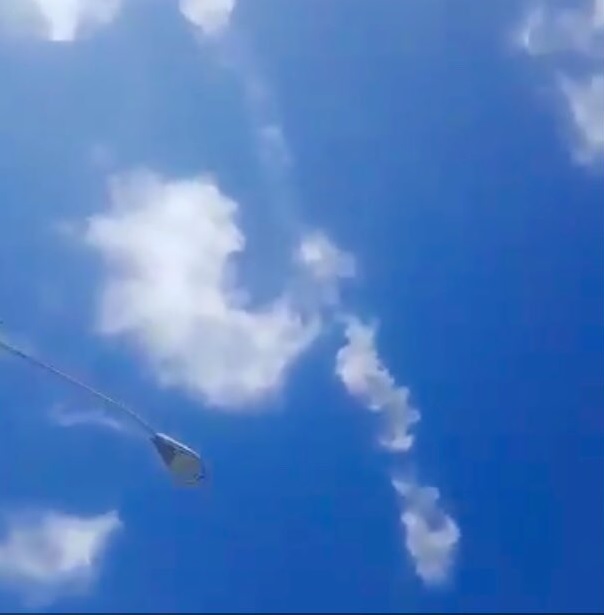
Several meteorites have been found in western Cuba after a huge meteor was seen by many – in broad daylight – on Friday, February 1, 2019. People in southern Florida also saw the meteor, as this space rock traveled over West Palm Beach, above the Florida Keys, and then to Viñales, a town in Pinar del Río, Cuba.
The event occurred at around 1:16 – 1:17 p.m. ET on Friday, February 1, 2019. Residents of Viñales, Cuba saw a very long smoke trail that lasted more than one minute, while the meteor itself was described as extremely bright, with yellow-orange color, and lasted more than at least four seconds.
Several Cuban residents reported finding back rocks showing the characteristic fusion crust seen in ordinary chondrites meteorites.

One of several stony meteorites found in Cuba on February 1, 2019, shortly after the huge meteor was seen across the skies. Image via Hatzel Vela.
Astronomers estimate that the space rock that disintegrated over Cuba was at least a few meters in diameter – likely, van-sized – before entering Earth’s atmosphere. That’s a lot smaller than the house-sized asteroid that entered Earth’s atmosphere over Chelyabinsk, Russia – also in February- in 2013. The shock wave from the Chelyabinsk event broke windows in six Russian cities and sent some 1,500 people to seek medical treatment, mostly from flying glass.
One of the witness of the Cuba meteor was Juan Alberto Pérez Pozo, who, immediately after seeing the amazing meteor, started recording the smoke trail and was able to capture the huge sonic boom at 0:46 on this video:
Meteorological satellites also recorded the event:
Remnants of the meteor over Viñales in western Cuba evident in #Goes16 GLM, Split Window Difference, and Sulfur Dioxide viewshttps://t.co/yQsbCadv4ghttps://t.co/WRmGQbnXPC pic.twitter.com/L4gLjCF4n6
— Brendon (@brendonme) February 1, 2019
The bright, yellow-orange color seen in the meteor suggests the space rock probably contains sodium. A similar composition was also seen in the Chelyabinsk meteorites, which were later recovered in a lake.
Reports indicate the sonic boom of the Cuba meteor also shattered windows, much as the Chelyabinsk meteor did; however, the Cuba event was at a smaller scale.
A web cam in Fort Myers, Florida, captured the meteor as it was descending towards Cuba:
Fireball meteor over Florida ends with meteorites falling on western Cuba! https://t.co/S3zyHIOIl4#fireball #bolide #meteor #meteorites #Viñales #Cuba pic.twitter.com/9JXtvPue7w
— Scott Sutherland (?????????) (@ScottWx_TWN) February 2, 2019
This map shows the trajectory of the huge meteor:

Trajectory of the huge meteor seen from Florida and Cuba. Illustration by Google Earth / Eddie Irizarry
Here’s another view of the meteor’s flash, seen from a satellite:
New Blog Post: @NOAA's #GOESEast's #GLM "sees" apparent #meteor flash in Western Cuba. @NWSKeyWest https://t.co/i58rlK8elO pic.twitter.com/CVx0uda4EV
— NASA SPoRT (@NASA_SPoRT) February 1, 2019
Other small asteroids passed very close to Earth in the past few weeks, including asteroid 2019 BZ3, a 23-foot (7-meter) space rock that came at just 0.1 or 10% the Earth-moon distance, on January 27, 2019.
Good-sized meteors do strike Earth’s atmosphere frequently. Fortunately, Earth’s atmosphere causes most of these space rocks to disintegrate. According to astronomers who study asteroids, Earth is in no imminent danger of collision with any large, dangerous asteroid.
Bottom line: A small space rock exploded in midair over Cuba, and pieces of it (meteorites) have been found.
from EarthSky http://bit.ly/2DQ8sNk

Several meteorites have been found in western Cuba after a huge meteor was seen by many – in broad daylight – on Friday, February 1, 2019. People in southern Florida also saw the meteor, as this space rock traveled over West Palm Beach, above the Florida Keys, and then to Viñales, a town in Pinar del Río, Cuba.
The event occurred at around 1:16 – 1:17 p.m. ET on Friday, February 1, 2019. Residents of Viñales, Cuba saw a very long smoke trail that lasted more than one minute, while the meteor itself was described as extremely bright, with yellow-orange color, and lasted more than at least four seconds.
Several Cuban residents reported finding back rocks showing the characteristic fusion crust seen in ordinary chondrites meteorites.

One of several stony meteorites found in Cuba on February 1, 2019, shortly after the huge meteor was seen across the skies. Image via Hatzel Vela.
Astronomers estimate that the space rock that disintegrated over Cuba was at least a few meters in diameter – likely, van-sized – before entering Earth’s atmosphere. That’s a lot smaller than the house-sized asteroid that entered Earth’s atmosphere over Chelyabinsk, Russia – also in February- in 2013. The shock wave from the Chelyabinsk event broke windows in six Russian cities and sent some 1,500 people to seek medical treatment, mostly from flying glass.
One of the witness of the Cuba meteor was Juan Alberto Pérez Pozo, who, immediately after seeing the amazing meteor, started recording the smoke trail and was able to capture the huge sonic boom at 0:46 on this video:
Meteorological satellites also recorded the event:
Remnants of the meteor over Viñales in western Cuba evident in #Goes16 GLM, Split Window Difference, and Sulfur Dioxide viewshttps://t.co/yQsbCadv4ghttps://t.co/WRmGQbnXPC pic.twitter.com/L4gLjCF4n6
— Brendon (@brendonme) February 1, 2019
The bright, yellow-orange color seen in the meteor suggests the space rock probably contains sodium. A similar composition was also seen in the Chelyabinsk meteorites, which were later recovered in a lake.
Reports indicate the sonic boom of the Cuba meteor also shattered windows, much as the Chelyabinsk meteor did; however, the Cuba event was at a smaller scale.
A web cam in Fort Myers, Florida, captured the meteor as it was descending towards Cuba:
Fireball meteor over Florida ends with meteorites falling on western Cuba! https://t.co/S3zyHIOIl4#fireball #bolide #meteor #meteorites #Viñales #Cuba pic.twitter.com/9JXtvPue7w
— Scott Sutherland (?????????) (@ScottWx_TWN) February 2, 2019
This map shows the trajectory of the huge meteor:

Trajectory of the huge meteor seen from Florida and Cuba. Illustration by Google Earth / Eddie Irizarry
Here’s another view of the meteor’s flash, seen from a satellite:
New Blog Post: @NOAA's #GOESEast's #GLM "sees" apparent #meteor flash in Western Cuba. @NWSKeyWest https://t.co/i58rlK8elO pic.twitter.com/CVx0uda4EV
— NASA SPoRT (@NASA_SPoRT) February 1, 2019
Other small asteroids passed very close to Earth in the past few weeks, including asteroid 2019 BZ3, a 23-foot (7-meter) space rock that came at just 0.1 or 10% the Earth-moon distance, on January 27, 2019.
Good-sized meteors do strike Earth’s atmosphere frequently. Fortunately, Earth’s atmosphere causes most of these space rocks to disintegrate. According to astronomers who study asteroids, Earth is in no imminent danger of collision with any large, dangerous asteroid.
Bottom line: A small space rock exploded in midair over Cuba, and pieces of it (meteorites) have been found.
from EarthSky http://bit.ly/2DQ8sNk


Aucun commentaire:
Enregistrer un commentaire